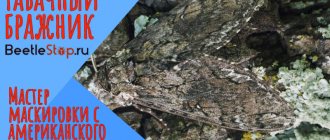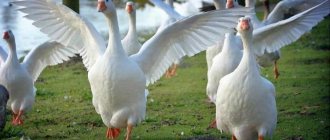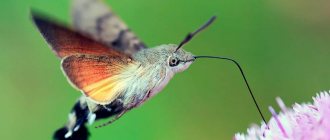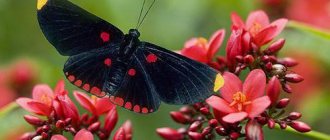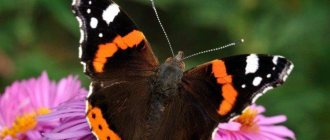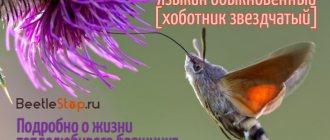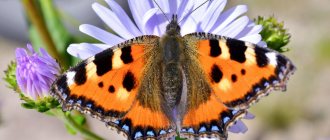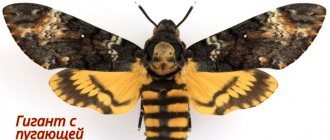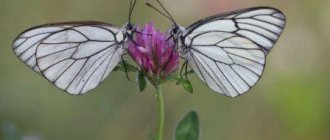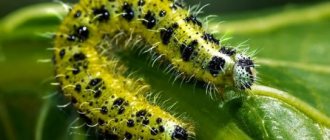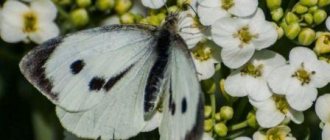Review author: “ZooVita”
The hawk moth butterfly is a very ancient representative of the order Lepidoptera. Its two alternative names are also known: “death’s head” and hummingbird butterfly.
Both names are associated with the phenotypic characteristics of insects: the image on the insect’s head resembles a skull, and the rapid movements of the wings allow us to compare the insect with the original hummingbird.
Growing and keeping butterflies?
So you have N number of pupae.
Then we wait for the butterflies to come out. I repeat, the “pupa” stage lasts 28 days (“+” “-” 2 days). During this time, you can start cooking for them at home. To keep a group of butterflies (I had 13 of them), use any convenient container with a minimum size of 40x40x40. Let's look at a few options: 1. The most convenient is the flexarium. You can either buy a branded, beautiful and expensive one, or make it yourself. Usually this is a frame covered with mesh. 2. Suitable size terrarium. I don’t think it’s very convenient, because... In factory terrariums there are a lot of different lyes and it will be difficult to collect eggs. And it will be necessary to cover the glass with mesh so that the butterfly can sit on it. 3. Aquarium. In this case, a lid and ventilation are required, as well as a mesh, as in the option above. 4. Mesh cage. As an option, nets for children's toys, fishing tackle, etc. 5. Free range. Not a very good option. Because butterflies spray everything around with brown liquid. Eggs will have to be collected throughout the house, plus nocturnal butterflies will fly at night and make noise like “helicopters”.
We have decided on a house for butterflies.
Arrangement:
As I said above, if you have a glass container, you can cover it with mesh so that butterflies can sit on it, because... They are nocturnal and fly only at night; they spend the entire daylight hours alone. It is also better to put some kind of plant, either artificial or live. I grew a sweet pepper bush in advance and placed it in the middle of the flexarium. Butterflies, both on it and throughout the container, will drop eggs. It was convenient for me to collect eggs from a flower, because... the butterflies sit quietly during the day, I just took out the pot and removed the eggs from all the leaves. I didn't put anything on the bottom. The floor of my flexarium is made of polystyrene foam. It was convenient to collect eggs that fell from it. Otherwise, you can lay down paper towels, newspaper or coconut substrate, but for me the latter is not convenient, because... eggs may well get lost in it.
Nutrition?:
For feeding, you need to make a simple feeder. This is the most convenient and problem-free option. You can also install light-colored lids, but this is not convenient. I will describe exactly my experience. We fill the finished feeder with food - this is syrup (10% solution of honey or sugar in water) and attach it to the “house”. I attached the feeder to a sushi stick and inserted it into the pepper pot. It must be secured so that butterflies can freely fly up and drink the syrup with their long proboscis. Eating usually starts on the second day. My 13 butterflies ate all the syrup overnight. I poured a fresh one every morning. It is worth noting that if you make syrup from non-natural honey, it quickly deteriorates and you have to make new syrup every day. Be very careful if there are ants at home, they will definitely come to feast on the butterflies.
I didn't do any additional lighting. The butterflies found food well and fed.
Lifespan:
With daily feeding, butterflies live quite a long time, about 2 weeks. females die faster for obvious reasons. I even had to release the last males into the wild, fortunately it was a warm time. and their noisy, already meaningless “flights” were no longer needed, because the females did their job and departed to another world. Yes, and females alone are of no use either, even if there was mating, then fertilized eggs will only be in the first clutch, and then there will be empty ones.
Literally on the second night, females begin to lay eggs. But in my case, it was these first eggs that turned out to be empty. Either the butterflies did not eat, or the males did not fertilize. Don't know. Then, throughout their entire life, the females lay eggs wherever they can - decor, netting, feeder, etc. One female lays 50 eggs at a time. In my case, each female (and there were 6 of them) laid more than 500 pieces. I don’t know why my females are so fertile, maybe it’s due to daily nutrition. Collecting eggs is not difficult. They are quite dense and easy to remove.
Photo 1: feeder Photo 2-3: just hatched butterfly Photo 4: butterfly spread its wings Photo 5: DIY flexarium
Medium hawk moth: emerging from the pupa
An awkward fat body of a bright pink-green color with some rudimentary-looking shoots instead of wings crawled along the bottom of the container.
It was a very pitiful picture, and I thought with some disappointment that I had produced an underdeveloped freak. But it was not there! The newborn hawk moth climbed onto the wall and froze, while inside it pressure was being pumped into its wings, which began to slowly straighten.
A few minutes later, the wings were already hanging down the entire length of the body.
Medium wine hawk moth spreads its wings
The butterfly remained in this state for quite a long time, around 40 minutes. And then the wings finally straightened and opened. The wine hawk moth appeared before me in all its glory.
Brazhnik wine medium
Captivity
It is not uncommon to find tobacco hawk moths in captivity. The purpose of their breeding may be to use the larvae as food for various reptiles, fish and small mammals. In order to keep and breed them, you need to study a number of rules and requirements for caring for these beautiful insects. Before you get a tobacco hawkmoth, you need to think about the container where it will live.
Almost any container with dimensions of at least 40x40x40 will do. This container serves as a collection of larvae. For the development of butterflies you will need a medium aquarium, a mesh cage and a vertical terrarium with good ventilation. Branches of deciduous trees should be placed inside the aquarium, since this is where caterpillars can live. It is best to lay the bottom with soil and stones. In winter, the aquarium should be covered with sphagnum moss and damp sawdust.
It is worth considering that when the caterpillar begins to exceed 6 centimeters in size, it becomes ready for pupation. During this period, you can notice that she is restless, practically does not eat, and the color of the cover begins to fade. In order for this period to pass safely, the caterpillars are transplanted to the bottom of a separate container, which should contain at least 5 centimeters of peat. She will burrow into it and begin the process of transforming into the pupal stage.
Breeding hawk moths at home
To breed domestic hawkmoths, you need to maintain at least 14 hours of daylight, a temperature of about 22°C and a humidity of at least 55%. It is ideal to keep insects in a special insectarium, where all conditions for life are created. But if there is no such device, you will have to create suitable conditions in the room.
For lighting, use the directional light of a lamp. Maintain humidity by spraying warm water from a spray bottle near the animal. Provide the caterpillars with a spacious cage. Its volume depends on the number of larvae. Equip the walls of the cage with a mosquito net so that the caterpillar can crawl along it without slipping. Provide air access using ventilation holes if the cage is closed. Make the container for keeping the pupae open. But put in it a sufficient amount of peat or slightly damp moss. The pupa of the oleander hawkmoth will appear on the surface, the tobacco hawkmoth will appear at a depth of 5 cm in the soil, other species will be grounded deeper. A total thickness of 15 cm of soil will be sufficient. The substrate should not be overdried. To moisturize, spray it, but do not over-water it, or place a wet branch in the cage. To feed, the caterpillars will need their food plants. Place the branches with leaves in a container of water. But cover the water so that the caterpillars do not fall and die in it. If it is not possible to provide the necessary greens, give them artificial food for hawkmoth caterpillars. Butterflies feed in flight and are very mobile. Therefore, keep them in spacious gardens with flowering plants: this way they will feed naturally. You can also feed hawk moths at home with honey or jam diluted with water. There is no need to straighten their proboscis: lower the front legs into the solution for a short time; the butterflies have taste buds on them. Feed the hawk moths during the day. They fly at night and won't eat.
Please note: not all hawk moths need food. As adults, they feed on bedstraw, wine, euphorbia, tobacco, oleander, bindweed, and lilac hawkmoths
The following species are not eaten: ocellated, linden, poplar.
- At night, the death's head hawk moth robs bees. The butterfly pierces the honeycomb with its strong proboscis and drinks honey. At the same time, she buzzes like a bee. But the deception is not always successful: sometimes the bees attack the robber and bite him to death. After this, they mummify the butterfly and leave it in the hive.
- When threatened, many hawkmoth caterpillars are able to relax their muscles and simulate death.
- When in danger, the death's head hawk moth “sings”, or rather emits a sharp, loud squeak. The sound is generated by the butterfly releasing air from the foregut, which leads to vibration of the folds of the chitinous covering of the oral apparatus. In this species, caterpillars and pupae also sing.
- Flowers pollinated by night hawk moths begin to smell pleasant closer to night.
- In one minute, hawk moths fly a distance exceeding the size of their body by 23-25 thousand times.
- In the Middle Ages, Europeans called the lilac hawk moth “death’s head.” People were afraid to meet him because they considered him a harbinger of death.
Tobacco hawk moth caterpillar – don’t worry about chewing
“What do you feed your lizard?
— Crickets
- And what else?
“Do we need anything else?!”
Such a dialogue between a buyer and a consultant can often be heard in our store. But we all want our pets to feel good, well-fed and active. To do this, it is necessary to observe the correct conditions for keeping the animal and not forget about a balanced and varied diet.
The main foods for insectivorous lizards and amphibians are crickets and marbled cockroaches. Zophobas larva is most often used as a treat, and large Madagascar cockroaches and locusts are convenient to feed to adolescents and adult animals. Alternating food will have a positive effect on the health of your pets, and if you are also breeding reptiles, this will only be a plus for the animals themselves and their offspring.
Tobacco hawk moth caterpillars are a new item in the range of feed at the EXOMENU.RU store. Many have been waiting for the appearance of these plump creatures and can finally pamper their pets with succulent food. Manduca sexta has long been appreciated by terrarists in Europe and the USA. Hawkmoth is rich in calcium and moisture, but low in fat. During their life and overexposure in containers, the caterpillars feed on wheat germ, which is full of fatty acids and B vitamins.
Container with caterpillars
These caterpillars are recommended to be given to weakened and young reptiles, since the hawk moth lacks a chitinous covering, which can interfere with the rapid absorption of nutrients. The soft caterpillars look appetizing and terrarium animals happily eat them both from tweezers and when hunting on their own.
Like most caterpillars, Manduca sexta grows quite quickly, because almost the entire time they are in the container they are busy eating food and within 5 days they can grow from 2 to 6 cm. At low temperatures, growth slows down, so placing the container with hawk moth caterpillars in a cool place you can control their growth. Accordingly, in a warm room, the food for your reptiles will increase in size much faster.
Tobacco hawk moth caterpillar
Do not forget that it is advisable to fortify even the most nutritious food with the help of special additives, for example, Exocalcium and Exocalcium with vitamin D3.
Exocalcium and exocalcium with vitamin D3 from AQUAMENU
What attracts beautiful butterflies
These unique creatures are attracted to beautiful flowers in the garden, the fragrant nectar of which is included in the diet of hawk moths. The more different flowers, ornamental shrubs and fruit crops there are on the site, the higher the likelihood of these insects appearing. The wine hawk moth settles where grapes are grown.
Hawkmoth caterpillars eat the leaves of many cultivated plants, but they do not cause significant damage to these plants.
Synonyms
- Sphinx sexta
Linnaeus, 1763 - Protoparce sexta
- Phlegethontius sexta
- Sphinx carolina
Linnaeus, 1764 - Manduca carolina
- Phlegethontius carolina
- Protoparce carolina
- Macrosila carolina
- Protoparce jamaicensis
Butler, 1876 - Sphinx lycopersici
Boisduval, - Sphinx nicotianae
Boisduval, - Sphinx paphus
Cramer, 1779 - Protoparce griseata
Butler, 1875 - Protoparce leucoptera
Rothschild and Jordan, 1903 - Protoparce sexta luciae
Gehlen, 1928 - Protoparce sexta peruviana
Bryk, 1953 - Sphinx caestri
Blanchard, 1854 - Sphinx eurylochus
Philippi, 1860 - Sphinx tabaci
Boisduval, - Protoparce sexta saliensis
Kernbach, 1964
Ways to get rid of milkweed in your summer cottage
Despite the fact that the only type of milkweed grows in the garden, we still haven’t figured out how to fight it - there is no reliable remedy.
Therefore, several methods are applicable for his expulsion, complementing (but not replacing) each other.
Control methods include the use of:
- agrotechnical practices;
- chemicals;
- folk ways.
Agrotechnical methods
They represent a set of sequential operations, the result of which should be the depletion of the weed's rhizome - all its strength lies in it.
Regular, methodical tearing off of the regrown stems of the pest negates the attempt of the roots to grow a complex of “solar batteries” for themselves (after all, without photosynthesis produced by the leaves, the plant will die).
Removing weeds from the site
Therefore, the task of the owner of an area infested with milkweed is to carefully monitor the condition of the bush every day - allowing its shoots to grow to a considerable height is the same as planting new ones with your own hands.
In the case when planting is just being planned, and milkweed is already growing in a given place, you should excavate not only in depth, but also in breadth in order to select the underground shoots as completely as possible.
Excavation of the earth
If the weed has penetrated under the fence, neighboring summer residents should be involved in joint activities (otherwise the personal headache will soon become a common one).
Use of chemicals
If you wait until harvest time, the milkweed will not only spread even wider, but will also have time to produce seeds (this is another way for the plant to reproduce).
Milkweed seeds
Of the ready-to-use herbicides in convenient aerosol packaging, you should pay attention to:
- "Tornado";
- "Lontrel-300D";
- "Lapis lazuli";
- "Titus."
If you detect sprouting of milkweed among garden plants, you can specifically “burn” the weed with Roundup.
Following folk wisdom
It has been noticed that without sunlight, any plant loses its strength. The method of covering problem areas with light-proof material allows you to lime the most tenacious and hardy plant in a given place.
Since underground shoots are only storage areas for nutrients, and they are formed in the leaves, it is quite logical to deprive their production of the basis - the energy supplied by the sun. The leaves left without light will first turn pale, then wither and the life in them will dry up, and the roots will die along with them.
Any materials are suitable for covering - from black non-woven fabric (Lutrasil) to cardboard and newspapers, stacked on top of each other, to the level of light impermeability, in several layers).
Bed covered with black cloth
But a method that is so popular among summer residents as spilling milkweed soil with a saline solution (made from table salt) is not recommended. Because you should think about the future, because if root crops do not grow in a given area, then it is quite possible to quickly plant berry bushes (currants, gooseberries).
Conclusion
Since milkweeds are not just plants - products carefully selected for existence by evolution itself, they have to be fought with all available methods.
The question is, in the pursuit of momentary success, not to harm the overall health of the entire area (we are talking about measures similar to those taken in the fight against moles). For land is given not for years, but for centuries - not only for the present, but also for all future generations.
Synonyms
- Sphinx sexta
Linnaeus, 1763 - Protoparce sexta
- Phlegethontius sexta
- Sphinx carolina
Linnaeus, 1764 - Manduca carolina
- Phlegethontius carolina
- Protoparce carolina
- Macrosila carolina
- Protoparce jamaicensis
Butler, 1876 - Sphinx lycopersici
Boisduval, - Sphinx nicotianae
Boisduval, - Sphinx paphus
Cramer, 1779 - Protoparce griseata
Butler, 1875 - Protoparce leucoptera
Rothschild and Jordan, 1903 - Protoparce sexta luciae
Gehlen, 1928 - Protoparce sexta peruviana
Bryk, 1953 - Sphinx caestri
Blanchard, 1854 - Sphinx eurylochus
Philippi, 1860 - Sphinx tabaci
Boisduval, - Protoparce sexta saliensis
Kernbach, 1964
Caterpillars???
At this stage the most fun is read. The joy of collecting a large number of eggs (in my case 3000+) ends the moment the caterpillars begin to emerge. The most important disadvantage in my breeding experience is the unprepared cups of food, because... I hoped for my food. For now, in order. As soon as the babies start to hatch, they need to be moved into ready-made jars of food. The best and most convenient option is disposable containers. It's better to prepare them in advance. Of course, it all depends on your “harvest”. But I will describe exactly my “great” experience.
Cups for keeping babies:
It is necessary to take disposable vertical containers of 0.5 l (photo 1-2). Cover the walls and bottom with plastic mesh. Pour a small layer of prepared food (1-1.5 cm) onto the bottom and let it cool. Create ventilation with a thin needle (the baby is very small and will escape through large holes). Close the lid. We put it in the refrigerator. As soon as the food hardens, we take it out. We put the glass upside down, and put a napkin on the bottom (it turns out to be a lid). It is needed so that excess moisture from food and waste is absorbed into the napkin, otherwise the baby will get stuck and die. We transfer the babies into ready-made cups. They must stand with the food facing up. The kids will crawl along the net like a stalk to the food and eat. Their waste will fall down.
If you don’t have a lot of caterpillars, you can grow them directly in these cups. But since I had a lot of them, I transplanted them into larger containers as they grew. I placed a larger mesh in an arc in a large container.
How to transfer small caterpillars into a glass?
Indeed, the baby turns out to be very small. They have a spike on the back, which makes it convenient to carry them from place to place, but it is better not to do this too often. The spine is very delicate, I took it carefully with tweezers, without squeezing too hard. It's okay if you accidentally tear it off, but it's better to try not to do this.
Caring for caterpillars.
In fact, they eat a lot and, accordingly, ?. It is necessary to change the napkin every day, otherwise mold will form very quickly. And babies often go downstairs to shed quietly, and can easily get stuck in it and die. As the caterpillars grow and eat food, they need to be resettled in smaller numbers into new containers with food. When the “farm” is large, it is actually a very tedious job. Typically a caterpillar goes through 5 instars, i.e. 5 molts with constant availability of food and grows up to 7 cm.
The caterpillars must be kept at a temperature of 24-25C. Do not place in direct sunlight, but provide good lighting throughout the day.
If you need to slow down the growth of caterpillars, place them in a cool place, maybe even on the refrigerator door.
Next, if you are planning to breed hawk moth again, feed the required number of caterpillars again until pupation. And feed the rest as your pets grow and need them. Caterpillars released for further breeding can be fed with natural food. The geese grow faster on it.
Life cycle and reproduction
The life cycle of the tobacco hawk moth is 30-50 days. During this time, a complete transformation occurs:
- egg;
- larva;
- chrysalis;
- imago.
Insect reproduction is bisexual. Females are ready for fertilization a week after entering adulthood. Males are capable of multiple matings throughout their lives. Fertilization occurs during night flights. Butterflies of opposite sexes hover in the air, touching each other with the ends of their abdomen. Mating lasts several hours.
At the end of spring, females lay eggs on the underside of the leaves of food plants. Their eggs are round, 1 mm in diameter, greenish or transparent in color. After 2-5 days, larvae emerge from the clutch.
Information. Two generations of insects are replaced per year, in tropical latitudes - up to three or four.
Larvae and pupae
Hawkmoth larvae are phytophages; their diet consists of leaves and fruits of nightshade plants. On the thoracic segment they have 3 pairs of legs, and on the abdomen another 5 pairs. A striking feature of the larva is the red horn located in the back of the body. The length of the caterpillar is up to 80 mm, at birth – 6 mm. In nature, the main color of the tobacco hawk moth caterpillar is protective green. It is ensured by the presence of organic pigments in the diet. When kept in captivity, they are fed wheat products, which is why the larvae are turquoise in color.
Interesting fact. Nicotine found in tobacco leaves is considered poisonous for many living organisms. Tobacco hawk moth caterpillars have adapted to the substance and learned to process it into safe compounds. Nicotine is used by insects as a defense against enemies such as spiders.
There are 7 oblique transverse white lines visible on the body of the larva. The body is also covered with a pattern of black dots. In its development, the caterpillar goes through 5 instars. Its size changes after each molt. With poor nutrition, the larvae molt more often and grow longer. The average duration of the stage is 3 weeks.
An adult caterpillar of the tobacco hawk moth falls from the plant to the ground and burrows into a hole to a depth of 10-15 cm. Here it turns into a pupa. The large pupa, 4-6 cm long, has an elongated shape and a pronounced maxillary loop. Brown color. Under favorable conditions (at a temperature of 27°), the pupal stage lasts up to 18 days. When conditions worsen, it goes into diapause. This condition may last for several months. In June, the number of insects in diapause is 5%, and by August it increases to 90%. The reason for the inhibition of development is the reduction in daylight hours.
Proboscis Hawk Moth or Common Tongue
Description
The proboscis hawk moth, or common tongue hawk, is distinguished by gray front wings, on which a transverse pattern is inscribed, while the hind wings are decorated with a dark border on an orange background. The butterfly's wingspan spans up to 50 mm, and their flapping is so rapid that it is almost impossible to see them. The insect is of medium size. Its abdomen is decorated with a tassel of hairs, and it looks a bit like a bird's tail. This is why many people associate the hawk moth with hummingbirds. Butterfly caterpillars range in color from green to dark brown, however, before turning into a mature individual, the pupa turns red.
Reproduction
The insect produces offspring twice during the summer. Caterpillars of the first generation, preferring flooded areas of forest edges, appear in thickets of bedstraw and chickweed. As a rule, this occurs in early autumn (September, early October). The appearance of the second generation occurs in the summer (June, August).
Lifestyle and distribution
The common tongue is a heat-loving insect. It appears at the beginning of summer. Insects fly from the south, but representatives of the second generation fly to regions with warm climatic conditions with the autumn cold.
Insects are distributed throughout Europe, North Africa and India, Central Asia, and the Far East. In Russia, populations have been recorded in the Caucasus, Crimea, the south of the Urals and Siberia. Some individuals fly as far as Yakutsk and Syktyvkar. The proboscis prefers sunny edges, gardens, and can fly into city parks.
Synonyms
- Sphinx sexta
Linnaeus, 1763 - Protoparce sexta
- Phlegethontius sexta
- Sphinx carolina
Linnaeus, 1764 - Manduca carolina
- Phlegethontius carolina
- Protoparce carolina
- Macrosila carolina
- Protoparce jamaicensis
Butler, 1876 - Sphinx lycopersici
Boisduval, - Sphinx nicotianae
Boisduval, - Sphinx paphus
Cramer, 1779 - Protoparce griseata
Butler, 1875 - Protoparce leucoptera
Rothschild and Jordan, 1903 - Protoparce sexta luciae
Gehlen, 1928 - Protoparce sexta peruviana
Bryk, 1953 - Sphinx caestri
Blanchard, 1854 - Sphinx eurylochus
Philippi, 1860 - Sphinx tabaci
Boisduval, - Protoparce sexta saliensis
Kernbach, 1964
Caring for tobacco in the garden beds
How to grow smoking tobacco
Growing smoking tobacco is a simple process, but there are certain subtleties in it. Tobacco care consists of regular watering, loosening the soil around the bushes, removing weeds and timely feeding, of which ideally there should be at least three.
The first time tobacco is fed a few days after planting the seedlings in the ground, then after 2-3 weeks the second feeding should follow, and 2-3 weeks after the second - the third. As fertilizers, use a solution of chicken manure (1:10) or a solution of complex mineral fertilizer prepared according to the instructions.
In the photo: Blooming tobacco
To obtain higher quality smoking tobacco, the bushes should be topped, that is, approximately half of the flower shoots should be broken off. After this procedure, tobacco will begin to actively form stepsons, which also need to be removed.
Reproduction and life cycle
In Africa, death's head hawk moths live and reproduce throughout the year. To the north they produce 2 generations annually. Mating occurs at night (the time when hawk moths are active). Butterflies of both sexes fly to light sources. After fertilization, the female lays eggs on the leaves of food plants (for caterpillars). The average quantity in 1 clutch is 100 pcs.
In the development cycle of the larvae, 5 phases (instars) successively change, during which the growth of the caterpillar takes shape. It feeds on many plants and is a polyphage. Pupation occurs in an underground chamber.
The pupa is 5–7 cm long and has a smooth shiny surface. They are located in the soil in an earthen cocoon. The stage period is 4 weeks. During this period, hawk moth pupae are sensitive to low temperatures and may die from frost.
Reasons for appearance
Hummingbird butterflies are attracted to the garden by beautiful flowers with fragrant nectar: the insects feed on the sweet mass. The greater the variety of trees, shrubs, berries and vegetables a caring owner has, the higher the food supply for caterpillars and adults. The wine hawk moth lives in vineyards. Large butterflies often fly into the apiary.
Caterpillars eat greens. Large creatures actively gnaw the leaves of viburnum, lilac, willow, potatoes, dope, and jasmine.
How to get rid of red ants in an apartment? Learn methods of control using chemicals and folk remedies.
Effective methods for exterminating bedbugs in residential areas are described on this page.
Go here and read about how to get rid of fleas on your dog.
Botanical description of the species
Euphorbia hawkmoth (Hyleseuphorbiae) is an insect of the order Lepidoptera, the hawkmoth family. Large butterfly with a wingspan of 65-80 mm. The upperparts are olive green or brown. The forewings are gray or olive with light and brown stripes, spots and bands. Along the base of the wings of the spurge hawk moth are two white stripes, which, as can be seen in the photo, converge on the head. The hind wings are pink with a black spot at the base and a black border near the outer edge. The lower part of the body and wings are pink.
The abdomen consists of 10 segments, with spiracles located on the sides up to the 7th segment. The ring-shaped parts are separated by light stripes; the anterior segments have black spots. There are spurs on the front legs that the butterfly uses to groom its antennae. The abdomen has the shape of a cylinder with a pointed end. It consists of ring-shaped segments with spiracles. The eyes are convex, round, facet type. Butterflies are able to distinguish colors and objects in minimal light.
The sucking type oral apparatus is represented by a long proboscis. Most of the time, the proboscis is twisted into a spiral; when it flies up to a flower, the moth straightens it and lowers it between the petals. Butterflies are active at night. They spend the day sitting on trees or bushes, covered with wings. Moths are attracted to electric light and flock in large numbers to artificial light sources.
Description of the larva
The caterpillar of the spurge hawkmoth can have different basic colors - green, yellow, red-brown, black. In green individuals, the pattern consists of black and yellow spots, as well as white dots. There are 11 white spots visible on the sides of the larva, which are located on each body segment. The caterpillar has underdeveloped coral-colored abdominal legs, a red head and a longitudinal stripe along the back. The horn is red at the base and black at the end. The bright color serves as a warning to birds. Larvae that eat poisonous milkweed become poisonous themselves.
Types of hawk moth butterflies
At the present stage, entomologists distinguish quite a few subspecies of the hummingbird butterfly, among which the most interesting are the following:
- Euphorbia hawkmoth.
- Wine hawk moth, whose caterpillar prefers to settle and develop primarily on the grapevine.
- “Death's head”, recognizable by the characteristic pattern on the head. Representatives of the subspecies feed on honey and sap of flowering plants.
- Ocellated butterfly.
The proboscis hawk hawk is of interest. The names of existing subspecies are determined by the phenotypic characteristics and characteristics of the habitat, and the feeding habits of insects. It is by a number of external signs that you can recognize the hawkmoth butterflies in the photo.
Interesting Facts
The large species difference between these representatives of butterflies has led to the emergence of many interesting facts. For example:
- The death's head hawk moth hunts for honey at night, robbing it from bees. With the help of her long and strong trunk, she easily breaks through honeycombs and feeds on honey. At the same time, she makes buzzing sounds so as not to arouse suspicion among the bees. But it doesn't always work out. If the bees see a hawk moth, they attack and bite until they die.
- Some species of caterpillars can feign a dead state.
- Flowers pollinated by hawk moths smell better.
- The flight speed of hawk moths in one minute exceeds their body size by 25 thousand times.
- The death's head butterfly can sing. The sound of singing is like a very high-pitched squeak.
- These are such amazing hawk moth butterflies. The last noteworthy fact is the ability of hawk moths to emit ultrasounds to escape from bats.
Population and species status
Photo: Hawk Moth Butterfly
Despite the diversity of species, the hawk moth is listed in the Red Book, and many species of this butterfly are in the regional Red Books. Today, the total population of the insect is considered not to be endangered. It is even excluded from the Red Book of the Russian Federation. On the territory of Ukraine, the number remains threatening. In connection with this, it was assigned the third category, and it is listed in the country’s Red Book.
Various factors contribute to the decline in hawk moth populations in different regions:
- increase in the number of birds;
- treatment of forage crops with chemical insecticides;
- cutting down bushes and burning grass;
- human development of the habitual habitat regions of hawk moths.
A more favorable situation with the number of insects in the Transcaucasus. The climate here is milder, so many more pupae are able to survive the winter period.
In other regions, mass deaths of pupae and larvae are observed due to the treatment of vegetation with chemical insecticides to bait the Colorado potato beetle. Also contributing to the decline in numbers is the large number of birds for which caterpillars are the main source of food.
Development
The life cycle of a hawk moth consists of 4 stages: egg, larva (caterpillar), pupa, adult insect. In May-June, adult butterflies emerge from the pupae. The breeding season begins.
Ferromones, produced by females to attract males, play an important role in this process. Depending on the length of daylight hours during the summer season, the butterfly lays eggs 2-3 times.
After laying eggs, females of many species die. After 5-10 days, a caterpillar emerges from the egg. It actively feeds and grows, reaching large sizes.
Thanks to the bright color of the body with various stripes and eye-shaped spots, the hawkmoth caterpillar cannot be confused. There is a horn-like growth at the end of the body. Its color is a characteristic feature of the species.
The caterpillars turn into pupae, which hide in the ground. After 2-3 weeks, a butterfly emerges from the pupa. After the wings dry and straighten, the hawk moth takes off and goes in search of a partner for procreation.
Appearance and features
Photo: Hawkmoth butterfly similar to a hummingbird
Hawkmoths are considered relatively large insects and have characteristic features.
Signs of this type of lepidoptera:
- massive body;
- long thin wings. In this case, the front pair of wings is much longer than the rear pair. At rest, most often the lower pair of wings is hidden under the lower one, or they are folded in the shape of a house;
- antennae without round beads at the end;
- the body has a characteristic pattern that resembles tree bark.
The wingspan of these butterflies ranges from 3 to 10 centimeters. The body length is 10-11 centimeters. This species of Lepidoptera exhibits sexual dimorphism. Females are slightly larger than males. The weight of one adult female is 3-9 grams, male – 2-7 grams.
Size, body weight and color are largely determined by the subspecies. For example, the largest representative of this species is antheus. Its wingspan is 16-17 centimeters. The smallest is the dwarf hawk moth. Its wing span does not exceed 2-3 mm. Wine hawk moth has a characteristic dark red hue. Color is also largely determined by region of habitat and diet.
The butterfly has antennae that can be of varying lengths, spindle-shaped or rod-shaped. They are pointed and curved upward. In males they are much wider than in females. The oral apparatus of the hawk moth is represented by an elongated, thin proboscis. Its length can be several times the size of the body, and reaches 15-17 centimeters. The Madagascan hawk moth has the longest proboscis; its length exceeds 30 centimeters. In some subspecies it is short or underdeveloped. During the period when butterflies do not eat, it is simply rolled up into a tube.
On the lips of butterflies there are rather developed palps, which are curved upward and covered with scales. The insect has rather complex, large round eyes. They are slightly covered with shaggy eyebrows. Special infrared locators are built into the organs of vision. With their help, insects not only distinguish colors, but are also able to capture infrared invisible rays. The body of the insect is covered with rather dense, thick fibers. At the end of the body, the villi are collected into a brush or braid. Insects have fairly developed pectoral muscles, thanks to which they can develop high flight speeds.
Tobacco hawk moth caterpillar
Tobacco hawkmoth (Manduca sexta) is a species of butterfly of the genus Manduca from the hawkmoth family (Sphingidae). Widely distributed from the tropical regions of South America to the northern regions of the USA (Massachusetts), it is considered a pest of tobacco plantations, easily reproduces in captivity and is used in research as a “model organism”.
The life cycle of the tobacco hawk moth lasts from 30 to 50 days. This short period allows two generations to develop in most areas, and even three and four generations in a year in Florida.
The eggs of the tobacco hawk moth are spherical in shape and reach 1 mm. in diameter, transparent, greenish in color. As a rule, eggs are laid by the female on the underside of the leaves of the caterpillar's food plants; they can rarely be laid on the upper side. The caterpillars hatch 2-4 days after laying.
Caterpillars of the last instar tobacco hawkmoth reach up to 70 mm in length. They feed on plants of the Solanaceae family, usually tobacco, tomatoes, potatoes and species of the genus Datura. Typically, a caterpillar goes through 5 instars, but with poor nutrition, the number of instars can increase. Pupates in the soil.
The natural biological control of butterfly reproduction is the parasitic wasp of the Braconid family Cotesia Congregata, which lays eggs in the body of the caterpillar, where the wasp larvae develop. Infested caterpillars may be covered in multiple silken cocoons of this parasitic wasp, which are often mistaken for large eggs.
The pupal stage lasts about 18 days (at 17 hours of daylight and 27 °C). With shortened daylight hours, the pupa enters diapause, which can last several months.
The adult has a specific pattern on the abdomen, which consists of six pairs of yellowish-red squares.
Butterflies are bred either on tobacco plants and related tomatoes or on artificial food based on wheat. Breeding is simple, requiring 14 hours of daylight to prevent diapause.
The eggs are washed for 1-5 minutes in a disinfectant solution and placed on plants or food cubes. Hatching and development rate depend on temperature. When the moment of pupation arrives, the caterpillars change their behavior and begin to look for suitable shelter. For this, boards with drilled holes are used. The tracks are placed in the holes and closed with plugs. After pupation, the pupae are placed in special chambers. Sweetened water and tobacco leaves (or a related plant) are also placed there for the female to lay eggs after fertilization.
When grown on artificial food, which lacks the yellow xanthophyll pigment necessary for the green coloration of the butterfly, hawk moths are hatched with a bluish tint. On some types of artificial nutrition they can be even paler, to pale blue. If the diet lacks vitamin A and carotenoids, which are essential for visual pigment, butterflies may have poor vision.
>Tobacco hawk moth (lat. Manduca sexta). Keeping and breeding at home
Diet of the hawk moth butterfly
Most insects, including hawk moths, feed on pollen from flowering plants. Possible sources of nutrients for the butterfly are the inflorescences of the following plants:
- Poplar.
- Sea buckthorn.
- All fruit trees.
- Vegetables of the nightshade family (for example, tomatoes).
- Pollen of coniferous plants.
- Raspberries.
The feeding habits of insects include the consumption of pollen from datura, belladonna, milkweed and even oak. The tobacco hawk moth deserves special attention, the larva of which feeds mainly on tobacco leaves.
Some subspecies of butterflies feed on honey, and therefore are subject to mass destruction by apiary owners. These types of hawk moths are able to imitate the sound of a swarm of bees, and their dense proboscis easily penetrates a layer of wax honeycomb.
Links
- [https://www.danaida.ru/sem14/mans.htm Carolina hawk moth (Manduca sexta)] on the website [https://www.danaida.ru/ Butterflies] (Russian)
- [https://www.colostate.edu/Depts/CoopExt/4DMG/Pests/tomato.htm Manduca sexta: description on the Colorado State University website] (English)
- [https://ohioline.osu.edu/hyg-fact/2000/2113.html Nuisance Parasitic Wasps at Ohio State University Extension] (English)
- [https://www.butterfliesandmoths.org/species/Manduca-sexta Manduca sexta on the Butterflies and Moths of North America website] (English)
- [https://entomology.ifas.ufl.edu/creatures/field/hornworm.htm Manduca sexta on the University of Florida website] (English)
- [https://jeremyswan.com/materials/photography/index.html Manduca sexta: anatomy illustration] (English)
What do hawk moths look like?
Hawk moth is a moth, that is, a night butterfly. Therefore, it has characteristic features:
- Large body.
- The wings are thin, with the lower ones being significantly shorter than the upper ones.
- The antennae are smooth, without thickening.
- The pattern on the body is similar to the texture of tree bark.
During the flight, the butterfly flaps its wings very quickly, resulting in the impression that it is a tiny bird. The length of the body reaches 11 centimeters, and the wingspan is 3-17 cm. The weight of the moth is 2-6 grams, while the female can weigh up to 8 grams.
Butterflies feed on nectar
The length of the antennae may vary. They have a rod-like structure, the apex can be pointed or slightly curved. The mouthparts are long, which allows them to collect nectar without sitting on the flower.
It can reach 25 centimeters in length. In some types the proboscis is underdeveloped. Others have additional palps on the lips. The insect's eyes have a complex structure, are round in shape, and covered with tufts. The eyes of the hawk moth are capable of distinguishing ultraviolet spectra.
The body of the butterfly is long, slightly narrowed towards the abdomen. As a rule, it is densely covered with hairs, which at the end form a “braid” or brush. The pectoral muscles are especially developed, which allows them to quickly flap their wings, developing enormous speed. Sometimes it reaches 54 km/h. while the wings rise up to 3120 times per minute.
Butterflies have ways of covering long distances by migrating between continents.
Read on topic:
Features of the life activity of ladybugs
14.11.2020
Description of chironomids and their possible danger to humans
14.11.2020
What do cutworms look like and what harm do they cause?
14.11.2020
What do goliath beetles look like and can they be bred at home?
14.11.2020
Hawk moths are able to perfectly combine protective and repellent colors. The upper wings are similar to the bark, so it is difficult to find insects on trees. The lower ones are very bright and catchy. Therefore, when danger appears, the butterfly throws out its lower wings, thereby scaring away the enemy.
Hawk Moth is good at camouflage
Hawkmoths have long legs, matching the color of their wings. There are a pair of spurs on the shins; similar spines are also found on the paws. The moth has a total of 6 legs.
Reproduction
The hummingbird-like butterfly prefers to lay its eggs on food plants. She does this on the fly, attaching them one at a time. They form caterpillars, the size of which directly depends on the type of hawk moth. They can be yellow-green or brownish-red in color with white dotted warts, black spiracles and longitudinal stripes of white, yellow or red located near the “legs”. Almost immediately after their appearance, they begin to eat the leaves of the plants closest to the place of oviposition, as a result of which the shoots become bare and soon die. Hawkmoth caterpillars can cause significant damage to most agricultural crops, among which grapes and potatoes suffer most from their invasions.
Before pupation, hawkmoth caterpillars turn red and burrow into the ground without a cocoon. Despite the fact that the cover of the proboscis of the pupa is soldered, it still protrudes glue-like. The color of the pupa is light and can vary depending on the type of hawkmoth from gray-brown to bluish-green.
Habitat of the hawk moth butterfly
The hummingbird butterfly is a heat-loving insect, preferring to avoid regions with cold climates. Almost all species are distributed in tropical countries in the following areas:
- Countries of America (both continents).
- Russia, its warm regions.
- Africa and Australia.
You can meet the butterfly in European countries where warm and temperate climates prevail.
Synonyms
- Sphinx sexta
Linnaeus, 1763 - Protoparce sexta
- Phlegethontius sexta
- Sphinx carolina
Linnaeus, 1764 - Manduca carolina
- Phlegethontius carolina
- Protoparce carolina
- Macrosila carolina
- Protoparce jamaicensis
Butler, 1876 - Sphinx lycopersici
Boisduval, - Sphinx nicotianae
Boisduval, - Sphinx paphus
Cramer, 1779 - Protoparce griseata
Butler, 1875 - Protoparce leucoptera
Rothschild and Jordan, 1903 - Protoparce sexta luciae
Gehlen, 1928 - Protoparce sexta peruviana
Bryk, 1953 - Sphinx caestri
Blanchard, 1854 - Sphinx eurylochus
Philippi, 1860 - Sphinx tabaci
Boisduval, - Protoparce sexta saliensis
Kernbach, 1964
Life is short
If we consider the species of butterflies in general, then among them there are no ones that would live longer than two or three weeks. Those that can last a month are already real long-lived insects.
Some of the representatives of hawk moths are lucky enough to enjoy life for just a few days. Now we are talking about those that have neither a proboscis nor a digestive system. Such butterflies live only on the substances that the caterpillar has accumulated at one time.
Hummingbird butterflies, capable of obtaining food from flowering plants, delight us with their presence a little longer - up to a month.
Sometimes two generations of hawk moths are born a year - in May and September.
Synonyms
- Sphinx sexta
Linnaeus, 1763 - Protoparce sexta
- Phlegethontius sexta
- Sphinx carolina
Linnaeus, 1764 - Manduca carolina
- Phlegethontius carolina
- Protoparce carolina
- Macrosila carolina
- Protoparce jamaicensis
Butler, 1876 - Sphinx lycopersici
Boisduval, - Sphinx nicotianae
Boisduval, - Sphinx paphus
Cramer, 1779 - Protoparce griseata
Butler, 1875 - Protoparce leucoptera
Rothschild and Jordan, 1903 - Protoparce sexta luciae
Gehlen, 1928 - Protoparce sexta peruviana
Bryk, 1953 - Sphinx caestri
Blanchard, 1854 - Sphinx eurylochus
Philippi, 1860 - Sphinx tabaci
Boisduval, - Protoparce sexta saliensis
Kernbach, 1964
